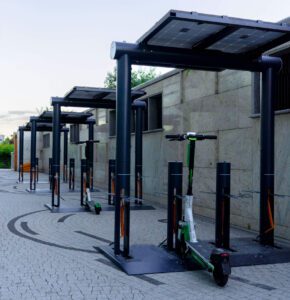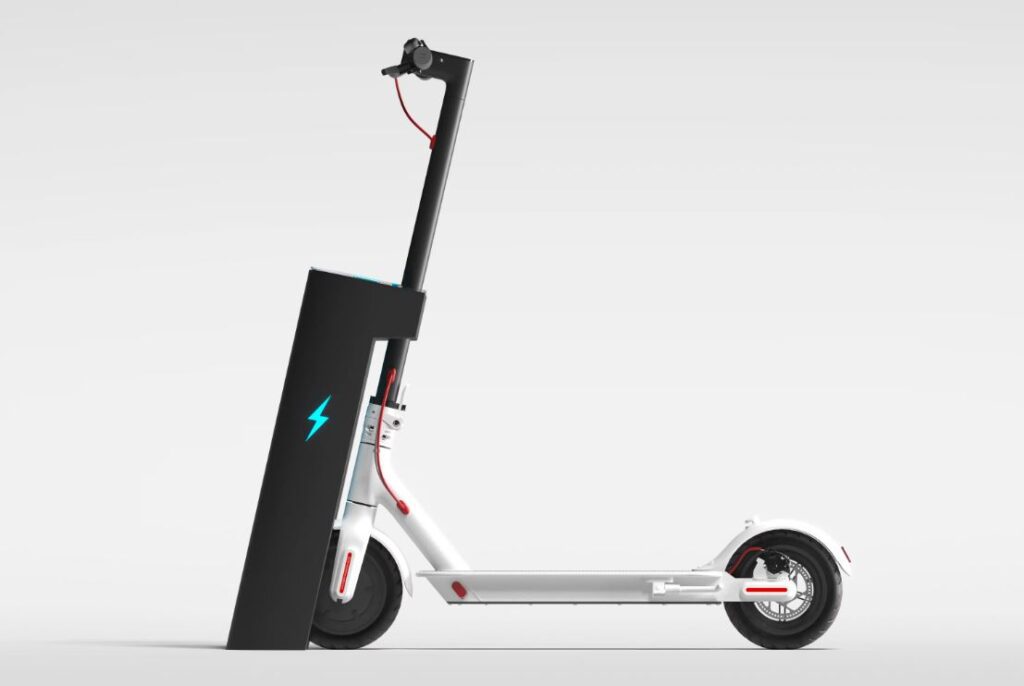Understanding Electric Scooter Batteries
Most modern electric scooters rely on lithium-ion batteries, which have become the industry standard due to their high energy density, lightweight design, and long cycle life. Unlike older lead-acid batteries, lithium-ion batteries offer superior performance, making them ideal for compact, portable vehicles like electric scooters. Battery capacity, measured in watt-hours (Wh) or ampere-hours (Ah), determines how much energy the battery can store, directly impacting the range per charge. For example, a 500Wh battery typically provides a longer range than a 250Wh battery, assuming similar motor efficiency and riding conditions.
The range of an electric scooter—how far it can travel on a single charge—varies widely depending on the model, battery specifications, and external factors. On average, most electric scooters offer a range of 15–40 miles (24–64 km) per charge, with entry-level models leaning toward the lower end (8–15 miles) and premium models reaching up to 60 miles or more. However, these figures are often based on ideal conditions, and real-world performance can differ significantly. Let’s explore the key factors that influence battery life per charge and how they interact to affect a rider’s experience.
Factors Affecting Battery Life Per Charge
Several variables determine how long an electric scooter battery lasts on a single charge. Understanding these factors can help riders optimize their scooter’s performance and plan their trips effectively.

1. Battery Capacity
Battery capacity, measured in watt-hours (Wh), is the primary determinant of range. A higher Wh rating means the battery can store more energy, allowing for longer rides. For instance:
- Entry-level scooters (e.g., Xiaomi Mi Electric Scooter) often have batteries around 200–300Wh, offering 10–18 miles of range.
- Mid-range scooters (e.g., Segway Ninebot KickScooter Max) typically feature 400–600Wh batteries, providing 20–40 miles.
- High-performance scooters (e.g., Apollo Phantom) may have batteries exceeding 1000Wh, achieving ranges of 40–60+ miles.
To calculate approximate range, divide the battery’s watt-hour capacity by the scooter’s average power consumption (in Wh per mile). For example, a 500Wh battery with a consumption rate of 15Wh per mile yields approximately 33 miles of range under ideal conditions.
2. Motor Power
The scooter’s motor power, measured in watts (W), affects how quickly the battery drains. A more powerful motor (e.g., 600W or higher) delivers faster speeds and better hill-climbing ability but consumes energy at a higher rate. For example, a scooter with a 250W motor will typically use less energy than one with a 1000W motor, resulting in a longer range for the same battery capacity. Riders who frequently use high-power modes or ride at top speeds will notice a significant reduction in range.
3. Rider Weight
The weight of the rider (and any cargo) directly impacts battery consumption. Heavier riders require more power to maintain speed, especially on inclines, which reduces range. For instance, a 200-lb rider may experience a 10–20% reduction in range compared to a 150-lb rider on the same scooter. Manufacturers often specify a maximum weight limit (e.g., 220–265 lbs), and exceeding this can further strain the battery.
4. Terrain
The type of terrain significantly affects battery life. Riding on flat, smooth pavement is far more energy-efficient than navigating hills, gravel, or uneven surfaces. Climbing steep inclines forces the motor to work harder, draining the battery faster. For example, a scooter that achieves 25 miles on flat roads might only manage 15 miles in hilly areas. Riders in urban environments with varied terrain should account for this when estimating range.
5. Speed and Riding Style
Aggressive riding habits, such as rapid acceleration and maintaining high speeds, increase power consumption. Most scooters have multiple riding modes (e.g., eco, standard, sport), with eco modes prioritizing range by limiting speed and power output. For example, riding at a steady 15 mph in eco mode can extend range significantly compared to maxing out at 25 mph in sport mode. Gentle acceleration and consistent speeds help maximize battery life.
6. Weather and Temperature
Extreme temperatures can reduce battery efficiency. Lithium-ion batteries perform best at moderate temperatures (20–25°C or 68–77°F). In cold weather (below 0°C/32°F), battery capacity can drop by 10–20%, reducing range. Similarly, excessive heat (above 40°C/104°F) can degrade battery performance and accelerate long-term wear. Riders should avoid charging or storing scooters in extreme conditions to maintain optimal battery health.
7. Battery Age and Health
As batteries age, their capacity naturally degrades. A typical lithium-ion battery maintains good performance for 300–1000 charge cycles, after which capacity may drop by 10–20%. For the average rider, this translates to 2–4 years of use or 3,000–10,000 miles before noticeable degradation. Proper maintenance can extend this lifespan, but older batteries will inevitably provide less range per charge.
Typical Range by Scooter Type
To provide a clearer picture, here’s a breakdown of typical ranges for different types of electric scooters, based on real-world data and manufacturer specifications:
- Entry-Level Scooters (e.g., Xiaomi Mi Electric Scooter, Gotrax GXL V2):
- Battery: 200–300Wh
- Range: 8–18 miles (13–29 km)
- Best for: Short commutes, casual riders
- Example: The Xiaomi Mi Electric Scooter offers about 18.6 miles with a 280Wh battery under ideal conditions.
- Mid-Range Scooters (e.g., Segway Ninebot KickScooter Max, TurboAnt X7 Pro):
- Battery: 400–600Wh
- Range: 15–40 miles (24–64 km)
- Best for: Daily commuters, urban riders
- Example: The Segway Ninebot Max achieves up to 40 miles with a 551Wh battery.
- Premium/High-Performance Scooters (e.g., Apollo Phantom, Dualtron Thunder):
- Battery: 800–1200Wh+
- Range: 30–60+ miles (48–96+ km)
- Best for: Long-distance riders, performance enthusiasts
- Example: The Apollo Phantom can reach up to 60 miles with a high-capacity battery.
These ranges are estimates based on ideal conditions (e.g., flat terrain, moderate speed, average rider weight, and optimal temperature). Real-world ranges are typically 70–80% of advertised figures due to the factors discussed above.
Maximizing Battery Life Per Charge
To get the most out of each charge, riders can adopt several best practices that optimize battery performance and extend range. These tips also help prolong the overall lifespan of the battery, reducing the need for costly replacements.
1. Charge Smartly
- Avoid Full Discharges: Recharging when the battery is at 20–30% capacity prevents deep discharges, which can stress the battery and reduce its lifespan.
- Unplug at 100%: Overcharging can degrade battery health. Most modern scooters have built-in battery management systems (BMS) to prevent this, but it’s still wise to unplug once fully charged.
- Use the Correct Charger: Always use the manufacturer’s charger or a compatible, certified alternative to avoid damaging the battery.
2. Ride Efficiently
- Use Eco Mode: Most scooters offer an eco mode that limits speed and power output, significantly extending range.
- Accelerate Gently: Smooth acceleration and steady speeds reduce power consumption compared to rapid starts and stops.
- Plan Routes: Choose flat, smooth routes whenever possible to minimize energy use. Avoid steep hills and rough terrain if range is a priority.
3. Maintain Optimal Conditions
- Store Properly: Store the scooter in a cool, dry place (ideally 20–25°C or 68–77°F) to prevent temperature-related degradation. For long-term storage, keep the battery at 50–70% charge and top it up periodically.
- Avoid Extreme Weather: Limit riding in extreme heat or cold, and never charge the battery in temperatures below 0°C (32°F) or above 40°C (104°F).
4. Monitor Battery Health
- Check Battery Indicators: Many scooters have apps or displays showing battery health and charge levels. Regularly monitor these to detect early signs of degradation, such as reduced range or slower charging.
- Replace When Necessary: Signs of a failing battery include a significant drop in range (30% or more), power fluctuations, or excessive heat during charging. Replacement batteries cost $100–$500, depending on the model.
Battery Lifespan and Replacement
While this article focuses on range per charge, it’s worth noting that a battery’s overall lifespan affects its performance over time. A typical lithium-ion battery lasts 300–1000 charge cycles, equating to 2–4 years for most riders. After this period, capacity may drop to 70–80% of its original value, reducing range. For example, a scooter that once traveled 30 miles per charge might only manage 21–24 miles after 500 cycles.
To determine when a battery needs replacement, look for:
- Reduced Range: A noticeable decrease in distance per charge.
- Longer Charging Times: The battery takes significantly longer to reach 100%.
- Physical Signs: Bulging, leaking, or unusual smells indicate a serious issue—stop using the scooter immediately and seek a replacement.
Replacement batteries are available from manufacturers, authorized dealers, or third-party retailers, but compatibility is crucial. Some scooters, like those from Bounce, offer removable battery systems for easy swaps. Upgrading to a higher-capacity battery may be possible for certain models, extending range, but always consult the manufacturer first.
Emerging Battery Technologies
Battery technology is evolving rapidly, promising to enhance electric scooter performance. Here are some innovations to watch:
- Solid-State Batteries: These use solid electrolytes instead of liquid ones, offering 50–100% higher energy density, faster charging, and 2000–3000 cycle lifespans. They also reduce fire risks, making them safer.
- Silicon-Carbon Anodes: These increase capacity by 20–40%, allowing for longer ranges without increasing battery size.
- AI-Powered Battery Management Systems: Advanced BMS can optimize charging and discharging, improving efficiency and lifespan.
While these technologies are not yet widespread, they could soon push electric scooter ranges beyond 60 miles and extend battery lifespans to 5+ years, revolutionizing the industry.
Real-World Examples
To illustrate how these factors play out, consider these popular models:
- Segway Ninebot KickScooter Max: With a 551Wh battery and 350W motor, it achieves up to 40 miles in eco mode under ideal conditions (150-lb rider, flat terrain, 15 mph). In real-world conditions (hills, 200-lb rider, mixed speeds), expect 25–30 miles.
- Apollo Phantom: Featuring a 1200Wh battery and dual 1200W motors, it can reach 60 miles in optimal conditions. However, aggressive riding or heavy loads may reduce this to 35–45 miles.
- Xiaomi Mi Electric Scooter: Its 280Wh battery delivers about 18 miles in ideal scenarios, but real-world range often falls to 12–15 miles for heavier riders or in cold weather.
User reviews and online forums can provide valuable insights into real-world performance, as manufacturer claims often assume perfect conditions. Checking watt-hour ratings and user experiences helps set realistic expectations.
Planning Your Rides
Understanding your scooter’s battery life per charge allows for better trip planning. Here’s how to apply this knowledge:
- Estimate Range Conservatively: Assume 70–80% of the advertised range for real-world conditions. For example, a 30-mile rated scooter might reliably deliver 21–24 miles.
- Map Your Route: Use apps like Google Maps to identify flat routes and avoid hills, maximizing range.
- Carry a Charger: For long trips, bring a charger or know where charging stations are available.
- Monitor Weather: Check forecasts to avoid extreme temperatures that could reduce range.
By combining these strategies with proper maintenance, riders can ensure their scooter meets their commuting or recreational needs without running out of power.
Conclusion
The battery life of an electric scooter per charge typically ranges from 15–40 miles, with high-end models reaching up to 60 miles or more. However, this range is heavily influenced by battery capacity, motor power, rider weight, terrain, speed, weather, and battery age. By adopting smart charging habits, riding efficiently, and maintaining the battery properly, riders can maximize range and extend the battery’s lifespan to 2–4 years or 300–1000 charge cycles. Emerging technologies like solid-state batteries and advanced BMS promise even greater ranges and durability in the future, making electric scooters an increasingly viable transportation option.
For riders looking to purchase a scooter, checking the watt-hour rating and reading user reviews can provide a clearer picture of real-world performance. By understanding and optimizing the factors discussed in this article, you can enjoy longer, more reliable rides and get the most out of your electric scooter’s battery. For further details on specific models or maintenance tips, consult manufacturer resources or trusted retailers like Segway, Apollo, or Bounce.



